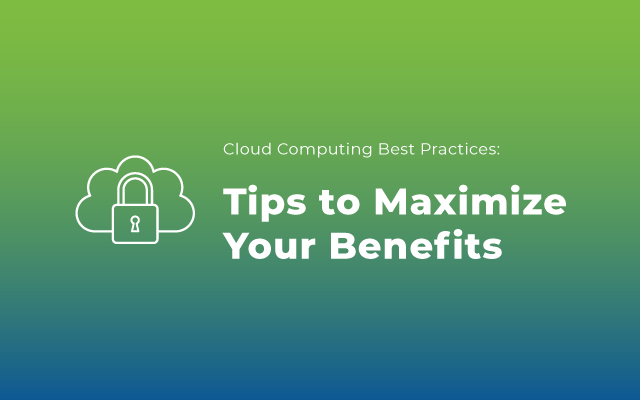Articles /
Cloud Computing Best Practices: Tips to Maximize Your Benefits

Use of the cloud drives multiple business benefits, including decreased time to market, increased security, and business growth.
And these benefits have become widely recognized. 87% of respondents to McAfee’s 2019 Cloud Adoption and Risk Report said they experience benefits from the cloud that drive business acceleration.
But it’s important to understand the technology and its unique attributes prior to migrating any infrastructure to the cloud. In our newest guide, ATS provides key background info and tips to maximize the benefits for your organization.
Cloud Defined
The term “cloud” is most accurately applied to those solutions that exhibit five essential characteristics of cloud computing, as defined by the National Institute of Standards and Technology (NIST):
- On-demand service
- Broad network access
- Resource pooling
- Rapid elasticity
- Measured service
Cloud service models include:
- Infrastructure as a Service (IaaS)
- Platform as a Service (PaaS)
- Software as a Service (SaaS)
The Growth of Cloud Adoption & Benefits Conferred
Cloud adoption continues to grow along with the awareness of the many benefits. Those organizations that weren’t already in the cloud promptly found themselves with no choice, as humorously pointed out in this tweet on March 30, 2020.
Migrating to the cloud enables a budgeting change from capital asset expenditures and maintenance to consumption-based pricing. Additionally, as opposed to IT hardware purchases, cloud enables smooth growth in capacity with corresponding gradual increases in cost.
Failing to Plan is Planning to Fail
To starting off a successful cloud migration:
- Have a clear direction. Don’t just chase what’s “shiny.”
- Balance different objectives & recognize benefits beyond cost savings
- Foster a supportive culture & give your teams permission to experiment & potentially fail
- Involve the appropriate stakeholders to earn their support, including rank & file staff
- Carry out POCs & pilots
- Be agile & consider making changes in smaller chunks with iterative improvements, minimizing the impact of any mistakes
New Skills Needed for Cloud Adoption
As part of your cloud migration strategy, you must identify any gaps in skills between your current IT environment and the future cloud environment. The Azure Cloud Adoption Framework (CAF) states, “The most important aspect of any cloud adoption plan is the alignment of people who will make the plan a reality. No plan is complete until you understand its people-related aspects.”
Cloud Migration Strategies
There are multiple ways of undergoing a cloud migration.
Lift and shift: Pick up your infrastructure and move it to the cloud as-is. In addition to bringing along existing problems, this can result in lost opportunities for cost savings.
Lift and refit: Make changes after the move to adapt applications so they work more effectively in the cloud environment.
Hybrid model: Move some workloads to the cloud while retaining some on-premises.
Cloud native: Technologies developed and built specifically for the cloud.
The important first steps to establishing your cloud migration strategy are:
- Analyze your current environment
- Determine, in detail, who and what will be affected by migration
- Decide what to move by conducting an application rationalization
- Consider both the size of your infrastructure as well as your level of urgency
- Choose migration tools that enable you to pre-move as much data as possible
- Consider your bandwidth needs and any network topology necessary during and after migration
Migrating Business Productivity Suite
The most common services and workloads to move are email (such as Microsoft Exchange), SharePoint and network shared drives into OneDrive for business. With email, ensure you migrate all mailbox data, including contacts, tasks, archive systems, PST files, and calendar items.
Also look at any minimum requirements that may exist for the cloud services you plan to move to.
The Complexities of Cloud Security
Cloud security is a “shared responsibility model.” It is critical to understand compliance requirements and responsibilities around data before engaging any third-party provider. Remember, ultimately, you are responsible for all the potential harm of a breach.
For a deeper dive, watch for your upcoming eBook, “Best Practices in Cloud Security.”
Do Your Homework & Leverage Expert Assistance for Digital Transformation
Thoroughly evaluate cloud vendors before selecting a provider. Migrating to the cloud is obviously a massive change and disruptive transformation to operations. As such, it’s important to have the guidance of experts who can help manage the change and drive maximum value.
Download our Cloud Computing Guide for more best practices including how to cope with the new hurdles raised by SaaS apps.